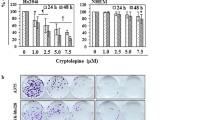Abstract.
Selenocystine (SeC), a naturally occurring selenoamino acid, has been shown to be a novel compound with broad-spectrum anticancer activity. In this study, we showed that SeC triggered time- and dose-dependent apoptosis in A375 human melanoma cells by activating the mitochondria-mediated and death receptor-mediated apoptosis pathways. Pretreatment of cells with a general caspase inhibitor z-VAD-fmk significantly prevented SeC-induced apoptosis. A375 cells exposed to SeC showed an increase in levels of total p53 and phosphorylated p53 (serine-15). Silencing of p53 expression with RNA interference significantly suppressed SeC-induced p53 phosphorylation, caspase activation and apoptotic cell death. Moreover, generation of reactive oxygen species and subsequent induction of DNA strand breaks were found to be upstream mediators of p53 activation induced by SeC. In a nude mice xenograft experiment, SeC significantly inhibited the tumor growth of A375 cells via induction of apoptosis. Taken together, these results suggest the potential applications of SeC in cancer chemoprevention.
Similar content being viewed by others
Author information
Authors and Affiliations
Corresponding author
Additional information
Received 12 June 2008, received after revision 02 July 2008, accepted 08 July 2008
Rights and permissions
About this article
Cite this article
Chen, T., Wong, Y.S. Selenocystine induces apoptosis of A375 human melanoma cells by activating ROS-mediated mitochondrial pathway and p53 phosphorylation. Cell. Mol. Life Sci. 65, 2763 (2008). https://doi.org/10.1007/s00018-008-8329-2
Published:
DOI: https://doi.org/10.1007/s00018-008-8329-2




